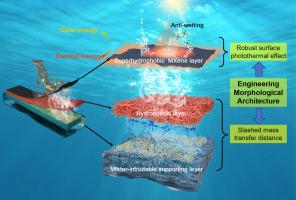用于高效光热膜蒸馏的超疏水/亲水复合膜的工程形态结构
IF 8.3
1区 工程技术
Q1 ENGINEERING, CHEMICAL
引用次数: 0
摘要
由于光热膜蒸馏(PMD)固有的能效和通量质量通量限制,其可行性和功效仍不确定。在此,我们开发了一种无分层的多层光热膜,通过形态结构的工程设计,同时实现了减小传质阻力、增强光热效应和提高憎水性的目的。利用一步式编程双通道电纺丝和静电喷涂技术,所提出的膜由厚的可渗透水的亲水支撑层、薄的疏水层和超薄的 Ti3C2Tx MXene 工程超疏水层组成。该形态结构工程可减轻传质阻力、提高憎水性和热定位能力。因此,在 PMD 运行期间(1.0 kW m-2),除了 1.27 L m-2 h-1 (20/20 °C 时的进料/过滤液)和 15.89 L m-2 h-1 (50/20 °C 时的进料/过滤液)的卓越通量外,拟议的复合膜(DS15-M)还实现了显著的太阳能效率(76.34 % 和 96.45 %)。此外,DS15-M 不仅具有强大的耐湿润性和长期一致性,而且在 PMD 运行期间明显减轻了温度极化效应。这项研究工作强调了形态结构在提高渲染性能方面的重要作用,这对永磁同步辐射应用的膜结构工程具有重要意义。本文章由计算机程序翻译,如有差异,请以英文原文为准。

Engineering morphological architecture of superhydrophobic/hydrophilic composite membrane for efficient photothermal membrane distillation
The viability and efficacy of photothermal membrane distillation (PMD) is still uncertain due to its inherent energy-efficiency and throughput mass flux limitation. Herein, we develop a delamination-free multilayer photothermal membrane that simultaneously imparts slashed mass transfer resistance, enhanced photothermal effect and strong water-repellency by engineering morphological architecture. Using a one-step programmed dual-channel electrospinning followed by an electrostatic spraying technique, the proposed membrane is composited by a thick water-intrudable hydrophilic supporting layer, a thin hydrophobic layer, and an ultrathin Ti3C2Tx MXene-engineered superhydrophobic layer. It is proposed that the morphological architecture engineering could render mitigation of mass transfer resistance, firm water-repellency, and robust heat localization. Hence, in addition to superior flux of 1.27 L m−2 h−1 (inlet feed/permeate at 20/20 °C) and 15.89 L m−2 h−1 (inlet feed/permeate at 50/20 °C), prominent solar efficiency (76.34 % and 96.45 %) of the proposed composite membrane (DS15-M) also was achieved during PMD operation (1.0 kW m−2). Moreover, the DS15-M showcased not only robust wetting resistance and long-term consistency, but also obviously mitigated temperature polarization effect during the PMD operation. This research work emphasizes the important role of morphological architecture in rendering performance enhancement, which is a significant implication in engineering membrane architecture for PMD application.
求助全文
通过发布文献求助,成功后即可免费获取论文全文。
去求助
来源期刊

Desalination
工程技术-工程:化工
CiteScore
14.60
自引率
20.20%
发文量
619
审稿时长
41 days
期刊介绍:
Desalination is a scholarly journal that focuses on the field of desalination materials, processes, and associated technologies. It encompasses a wide range of disciplines and aims to publish exceptional papers in this area.
The journal invites submissions that explicitly revolve around water desalting and its applications to various sources such as seawater, groundwater, and wastewater. It particularly encourages research on diverse desalination methods including thermal, membrane, sorption, and hybrid processes.
By providing a platform for innovative studies, Desalination aims to advance the understanding and development of desalination technologies, promoting sustainable solutions for water scarcity challenges.
 求助内容:
求助内容: 应助结果提醒方式:
应助结果提醒方式:


